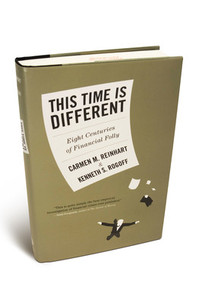Source of book image: http://si.wsj.net/public/resources/images/ED-AK313_book10_DV_20091008170122.jpg
(p. 762) Every once in a while, a work comes along whose key points ought to be part of the information set of every literate economist. Carmen M. Reinhart and Kenneth S. Rogoff’s This Time is Different: Eight Centuries of Financial Folly is such a work. It describes and analyzes a long international history of several types of financial crises.
. . .
The authors resist giving too much structural interpretation to their analysis. Most would agree with their conclusion that ” . . . highly leveraged economies, particularly those in which continual rollover of short-term debt is sustained only by confidence in relatively illiquid underlying assets, seldom survive” (p. 292).
For the full review, see:
Boskin, Michael J. “Review of: This Time Is Different: Eight Centuries of Financial Folly.” Journal of Economic Literature 48, no. 3 (September 2010): 762-66.
(Note: ellipsis internal to the final quotation, and the italics, are in the original; ellipsis between paragraphs is added.)
(Note: the “p. 292” refers to a page in the book, and not a page of the review.)(
The book being reviewed, is:
Reinhart, Carmen M., and Kenneth Rogoff. This Time Is Different: Eight Centuries of Financial Folly. Princeton, NJ: Princeton University Press, 2009.

